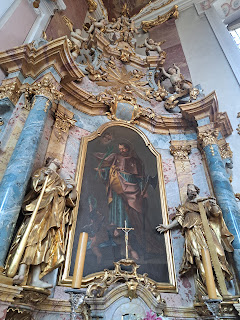Rivers know this: there is no hurry. We shall get there some day.
- A. A. Milne, Winnie-the-Pooh (1926).
I began my day walking beside the river, following the Mainthal Radweg riverside cycling path for five kilometres from Randersacker to Eibelstadt. Here I made a spur-of-the-moment decision to follow an alternate route through the vineyards, marked with the shell symbol of the pilgrimage routes to Santiago. I knew that as long as I followed the shells, I would end up in my hostel for tonight, which is on the Jakobsweg in Gaukönigshofen. A slight detour off the Via Romea, but it allows me to stay in a pilgrim hostel rather than a hotel, without making much of a difference to the total number of kilometres to Aub, the next stop on the Way.
 |
| Locks on the side canal by the Main river |
 |
| Elderflower |
 |
| Rathaus and maypole in Eibelstadt |
I stopped at a bakery in the town for a slice of rhubarb cheesecake, commonly found in bakeries in Germany and comparatively healthy - or at least that was my reasoning - though not particularly photogenic. It looks more like an onion frittata than a dessert! 😄
Eibelstadt is known for its wine, but it was early in the day for wine-tasting... so I detoured along an alternate route through the vineyards, taking the high road along the hillside, high above the river valley with the railway, the highway and cycling tracks beside it.
Then I returned to the river, its glassy surface gliding by as I walked south, upstream, into the sun.
By taking the high road through the vineyards I had missed the first bridge over the Main, which would have made my route shorter; I took the next available bridge and walked a kilometre or two along a narrow road also used by tractors and big trucks carrying loads of soil or rocks. Then I joined the Jakobsweg route again and followed a cycling track along a former railway line up the Thierbach valley to the village of Gaukönigshofen, which is off the Via Romea route but has a pilgrim hostel because it is on the pilgrimage route to Santiago. I was to notify the keeper of the keys half an hour before arriving, but at that time I was in a place with no signal. When I did manage to call, she didn't answer, so I sent her a message on WhatsApp. Then I waited outside the pilgrim hostel... until she called and asked where I was. Apparently I was supposed to go to her house to get the key first 😄 Though I don't recall her telling me that. In any case, we eventually found each other and I got checked in. Then I went out, without my backpack, to take a look around the village and stamp my pilgrim credential in the church.
A bit of history: Gaukönigshofen
Gaukönigshofen (population 2500) was first mentioned in writing in 741, as part of the newly founded diocese of Würzburg. The Pfarrkirche Heilige Schutzengel und St. Jakobus Maior, or Catholic Parish Church of the Guardian Angels and of St. James, built between 1724 and 1730, is thought to have been designed by the same architect as the Residenz in Würzburg, Balthasar Neumann. The interior of the church, featuring rich pink, white and gold stucco work in the style of early classicism with Rococo forms, is decorated with about a hundred angel figures.
 |
| In the painting over the high altar, a guardian angel takes a frightened child by the hand |
The church is on the Jakobsweg, the Way to Santiago, and is also dedicated to St. James, and so he appears in the decorations, too - also in pink and gold!
On my way back to the pilgrim house, I passed by the village's former synagogue and Jewish community centre. A Jewish community settled in Gaukönigshofen under the noble von Rosenbach family in the middle of the 16th century; the first synagogue was probably built around 1750. By 1830, a fifth of the town was Jewish.
On November 10, 1938, the synagogue was demolished during the night of the Kristallnacht pogroms, and its ritual objects and furnishings were removed. The chandeliers, Torah and rituals were burned and the Jewish school was completely demolished. On June 28, 1939, the Gaukönigshofen community bought a new synagogue and Jewish community centre and set up apartments there. But the entire Jewish community of Gaukönigshofen was deported and killed in the concentration camps. A memorial at the old train station recalls this.
Fifty years after Kristallnacht, the former synagogue was reopened as a memorial.
How exactly the house I am staying in fits into the town's Jewish history I'm not sure, but it is just down the road from the former synagogue and is called the Schutzjudenhaus Gaukönigshofen. A Schutzjude was, historically, a Jew granted the right to settle in a community by the sovereign. So the building must have originally been the home of a family of these "protected" Jews. Now it has been renovated for use as a pilgrim hostel, with a kitchen, dining area and bathroom downstairs and a sleeping area with several mattresses in the attic, where I am lying listening to the rain on the roof as I write this!
 |
| Healthy dinner, to make up for a lunch of cheesecake and wine! |
 |
| This will do nicely for tonight! |



























Husband definitely likes the sound of rhubarb cheesecake 😂
ReplyDeleteI particularly enjoyed the photo of the table with the white wine with crispy bread, along with your pack and what turned out to be - not a hiking guide, as I originally thought - but the pilgrim passport, which is a book in itself!!!
ReplyDeleteYes it is. You write your own guidebook, as you go!
Delete